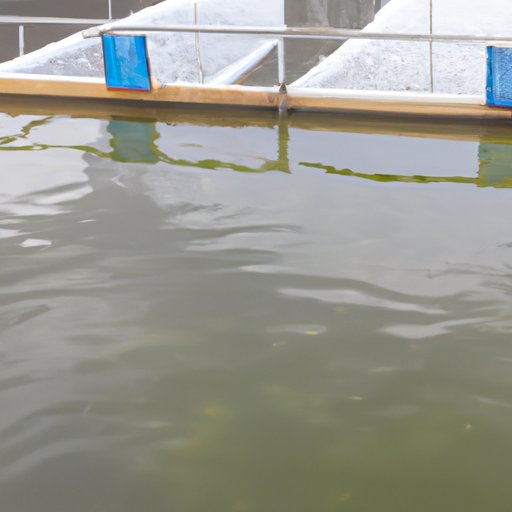
Introduction
Wastewater treatment plants are vital to modern society, providing a way to safely dispose of wastewater and prevent contamination of our environment. However, these plants would not be possible without the crucial role of microorganisms and other organisms that break down chemical wastes and pollutants. By unlocking the mystery of these organisms and understanding how they work together, we can better appreciate the importance of wastewater treatment and the critical role of these “unsung heroes.”
Unlocking the Mystery: The Organisms Responsible for Breaking Down Chemical Wastes in Treatment Plants
There are many different types of microorganisms and other organisms found in wastewater treatment plants, each with its own unique role in breaking down pollutants. These organisms include bacteria, fungi, algae, and protozoa, among others. They work together in complex ecosystems, breaking down pollutants and converting them into forms that can be safely discharged into the environment or reused for other purposes.
The key to the effective functioning of these organisms is their ability to break down different types of pollutants. Some organisms specialize in breaking down organic compounds, while others are particularly effective at removing nutrients like nitrogen and phosphorus. Still, others can break down complex chemical compounds that are resistant to other treatment methods.
The Unsung Heroes of Treatment Plants: Meet the Organisms That Make Clean Water Possible
While there are many different organisms at work in wastewater treatment plants, some are particularly important for their unique characteristics and abilities. These organisms include:
– Nitrifying bacteria: These bacteria are essential for removing nitrogen from wastewater, converting ammonia into nitrates that can be safely discharged.
– Anaerobic bacteria: These bacteria thrive in oxygen-poor environments and are crucial for breaking down organic compounds that would otherwise accumulate and cause problems in the treatment process.
– Protozoa: These microscopic organisms are important for removing suspended solids from wastewater, consuming and breaking down organic matter and other pollutants.
The Science Behind Wastewater Treatment: A Closer Look at Organisms That Break Down Chemical Wastes
The biological processes involved in breaking down pollutants in wastewater treatment plants are complex and interrelated. One of the most critical processes is the formation of biofilms, which are specialized communities of microorganisms that work together to break down pollutants. These biofilms can be found on various surfaces within the treatment plant, including the walls of tanks and pipes.
Within these biofilms, different types of microorganisms work together, sharing nutrients and breaking down pollutants in a coordinated way. Some produce enzymes that break down complex compounds, while others consume the resulting byproducts and convert them into forms that can be safely discharged.
Breaking Down Barriers: How Organisms in Treatment Plants Keep Our Water Safe
One of the most significant benefits of using organisms to break down chemical wastes in wastewater treatment plants is their ability to treat a wide range of pollutants. Unlike physical or chemical treatment methods, which may only be effective for certain types of pollutants, biological treatments can be tailored to target a range of chemical compounds and organic matter.
In addition, using organisms to treat wastewater is often more energy-efficient and cost-effective than other treatment methods. By harnessing the power of natural processes, wastewater treatment plants can reduce their environmental impact and operate more sustainably.

From Waste to Clean Water: A Journey Through the Organisms that Break Down Chemical Wastes in Treatment Plants
The wastewater treatment process is a complex journey that involves many different stages and processes. At each stage, different types of organisms play a crucial role in breaking down pollutants and producing clean water.
The first stage of wastewater treatment is primary treatment, which involves the removal of large suspended solids and organic matter. This is accomplished using a variety of physical and biological processes, including the use of screens, settling tanks, and bacteria that break down organic waste.
The next stage is secondary treatment, which involves the use of biological processes to break down more complex compounds and produce cleaner water. This is achieved using a variety of methods, including activated sludge, trickling filters, and rotating biological contactors. These processes rely on different types of microorganisms and other organisms to break down pollutants and produce clean water.
The final stage of treatment is tertiary treatment, which involves the use of additional treatment methods to produce high-quality water that can be safely discharged into the environment or reused for other purposes. This may include the use of advanced filtration technologies, chemical treatment, or disinfection processes.
The Next Level of Sustainable Wastewater Treatment: Harnessing the Power of Organisms to Break Down Chemical Pollutants
As wastewater treatment becomes an increasingly critical concern for communities around the world, researchers are exploring new ways to make the process more sustainable and effective. One area of focus is on harnessing the power of organisms to generate energy or further break down chemical pollutants.
For example, researchers have experimented with using microbial fuel cells to generate electricity from wastewater. These cells use bacteria to break down organic matter and produce electricity as a byproduct. Other researchers are exploring ways to use genetically-engineered microorganisms to break down specific types of chemical pollutants more effectively.
Conclusion
The organisms that break down chemical wastes and pollutants in wastewater treatment plants are the unsung heroes of this critical process. By working together in complex biological processes, these organisms ensure that we have access to clean, safe water and protect our environment from contamination. As we continue to explore new developments in this area, it’s essential to remember the crucial role that these organisms play in wastewater treatment and to look for ways to support their vital work.





